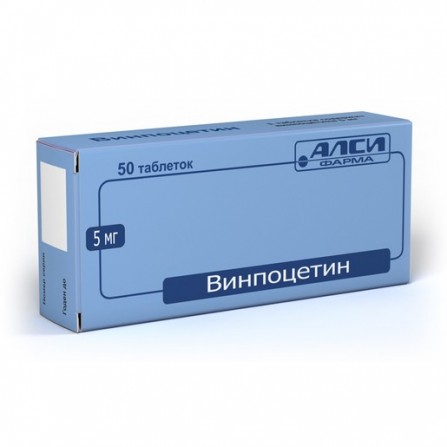More info
Active ingredients
Vinpocetine
Release form
Pills
Composition
Vinpocetine 5 mg; Excipients: potato starch - 64.3 mg, lactose monohydrate (milk sugar) - 171.9 mg, colloidal silicon dioxide (aerosil) - 1.7 mg, talc - 4.7 mg, magnesium stearate - 2.4 mg.
Pharmacological effect
Vasodilating preparation. It improves brain metabolism by increasing the consumption of glucose and oxygen by the brain tissue. Increases the resistance of neurons to hypoxia; facilitates glucose transport to the brain, through the BBB; translates the process of glucose decomposition into an energetically more economical, aerobic way; selectively blocks Ca2 + -dependent phosphodiesterase; increases the content of adenosine monophosphate (AMP), cyclic guanosine monophosphate (cGMP), ATP, noradrenaline, serotonin and the ratio of ATP / AMP in brain tissues; has an antioxidant effect.; Reduces platelet aggregation and increased blood viscosity; increases the deforming ability of erythrocytes and blocks the utilization of adenosine by erythrocytes; promotes increase in return by red blood cells of oxygen.; Increases cerebral blood flow; reduces the resistance of cerebral vessels without significant changes in the systemic circulation. Does not have the effect of "stealing" and increases blood circulation, primarily in ischemic brain areas.
Pharmacokinetics
Rapidly absorbed. The time to reach Cmax in the blood plasma is 1 hour. Absorption occurs mainly in the proximal gastrointestinal tract. When passing through the intestinal wall is not metabolized. Cmax in tissues is observed 2-4 hours after ingestion.; Communication with proteins - 66%, absolute bioavailability when administered orally - 7%, increases with the use of the drug after a meal. The clearance of 66.7 l / h exceeds the plasma volume of the liver (50 l / h), which indicates extrahepatic metabolism.; At repeated doses, the kinetics is linear. T1 / 2 in humans 4.83 ± 1.29 h. Excreted by the kidneys and through the intestines at a ratio of 3: 2. Penetrates the placental barrier.
Indications
- neurological and mental symptoms in various forms of cerebral circulatory failure (including the recovery stage of ischemic or hemorrhagic stroke, the consequences of a stroke,transient ischemic attack, vascular dementia, vertebrobasilar insufficiency, cerebral vascular atherosclerosis, post-traumatic and hypertensive encephalopathy) ;; - chronic vascular diseases of the choroid and retina (due to arteriosclerosis, angiospasm, thrombosis); degenerative changes in macula caused by atherosclerosis or angiospasm; secondary glaucoma (due to vascular obturation) ;; - age-related vascular or toxic (drug-induced) hearing loss, Meniere's disease, idiopathic tinnitus, labyrinth dizziness ;; - vasovegetative manifestations of the menopausal syndrome.
Contraindications
- acute phase of hemorrhagic stroke, ischemic heart disease, pronounced arrhythmias ;; - pregnancy (placental bleeding and spontaneous abortions are possible, probably as a result of increased placental blood supply) ;; - lactation period (breastfeeding should be discontinued) ;; - children under 18 (due to insufficient data) ;; - hypersensitivity to any of the components of the drug.; Tablets contain lactose, therefore, the drug should not be taken by patients with rare hereditary diseases such as neper galactose intolerance, lactase deficiency or glucose-galactose malabsorption;
Use during pregnancy and lactation
Contraindicated
Dosage and administration
Inside 5 mg (1 tab.) After a meal. The drug is used 3 times / day. The initial daily dose is 15 mg. The maximum daily dose of 30 mg. Duration of treatment up to 3 months. Repeated courses are possible 2-3 times a year.; For diseases of the kidneys or liver, the drug is prescribed in the usual dose.; Before withdrawal, the dosage of the drug should be gradually reduced.
Side effects
On the part of the cardiovascular system: ECG changes (ST depression, prolongation of the QT interval), tachycardia, extrasystole, blood pressure lability, tidal sensation. From the side of the central nervous system: sleep disturbances (insomnia, increased drowsiness), dizziness, headache, general weakness, increased sweating. On the part of the digestive system: dry mouth, nausea, heartburn. Skin allergic reactions.
Overdose
Symptoms: increased severity of side effects. Treatment: gastric lavage, taking activated charcoal, symptomatic therapy.
Interaction with other drugs
No interaction was observed with simultaneous use with beta-blockers (chloranolol, pindolol), clopamide, glibenclamide, digoxin, acenocoumarol and hydrochlorothiazide, imipramine. The simultaneous use of vinpocetine and methyldopa sometimes caused some enhancement of the hypotensive effect, therefore, such treatment requires regular monitoring of blood pressure. Increases the risk of hemorrhagic complications on the background of heparin therapy. Despite the lack of data confirming the possibility of interaction, it is recommended to be cautious with the simultaneous appointment with drugs of central, anti-arrhythmic and anticoagulant action.
special instructions
The presence of prolonged QT syndrome and the use of drugs that cause lengthening of the QT interval, requires periodic monitoring of the ECG. Impact on the ability to drive motor vehicles and control mechanisms There are no data on the effect of Vinpocetine on the ability to drive a car and perform work requiring psychomotor reactions.



